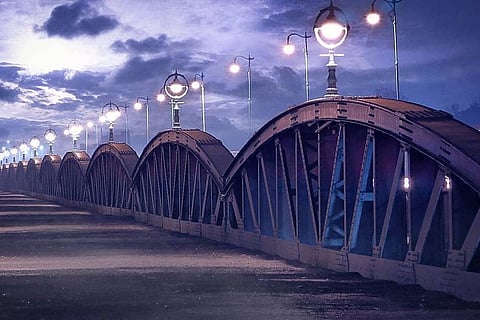Transcending Time: The fascinating story of Ellis Bridge in Ahmedabad
As we pass through the beautifully illuminated Ellis Bridge, with the meandering Sabarmati River beneath, we can't help but be captivated by the chaotic yet mesmerizing landscape of Ahmedabad. This architectural marvel stands as a symbol of the city's rich heritage, a steadfast testament to its glorious past.
This iconic structure celebrates its 131st anniversary, so let's embark on a journey to explore the origins and remarkable history of Ellis Bridge, altering the landscape of Ahmedabad, moulding it into the vibrant city it is today.
Humble beginnings as Lakadiya Bridge
During their rule, the British, to propel the industrial revolution, decided to construct a bridge spanning the river Sabarmati, connecting the western and eastern parts of the city. Thus, a wooden bridge was erected in 1870-71 known as the Lakadiya Bridge. But its fate was sealed when the devastating floods of 1875 washed away the structure.
Recognizing the vital role of the bridge in facilitating transportation and further expansion, the British administration resolved to construct a new steel bridge, one that could withstand the harsh environmental challenges.
The inception of Ellis Bridge
Himmatlal Dhirajram Bhachech, a master engineer was given the charge of the project. The steel required for the new bridge was imported from Birmingham. In 1892, the construction was completed. This bowstring arch truss bridge proudly bore the name of Sir Barrow Helbert Ellis, the commissioner of the north zone. Interestingly, Himmatlal accomplished this feat within a budget of Rs 4.07 lakhs, lower than the estimated Rs 5 lakhs.
This achievement surprised the British, sparking suspicions about the quality of the bridge. However, upon thorough inspection, they discovered that the bridge not only met their expectations but surpassed them, leading to Himmatlal being honored with the title of Rao Sahib for his commendable efforts in saving government funds.
A bridge that reshaped Ahmedabad
Ellis Bridge, beyond serving as a conduit for crossing the river, played a transformative role in the development of residential and industrial areas beyond the earlier walled city. It bore witness to significant historical events and became an emblem of change.
In 1921, during the Sardar Patel-led boycott of foreign goods, a towering bonfire of foreign clothes was ignited, casting a flickering glow upon the bridge. Moreover, it was on Ellis Bridge that Mahatma Gandhi declared the momentous Dandi Yatra on March 8, 1930. This historic structure not only left an indelible mark on the city but also played an instrumental role in shaping the destiny of the nation.
The threat of demolition
Despite facing numerous challenges throughout its existence, Ellis Bridge managed to overcome the threat of demolition on several occasions. Recognizing its cultural significance, the Ahmedabad Municipal Corporation designated the bridge as a protected site in 1989, ensuring its preservation for future generations.
Renamed as Swami Vivekananda Bridge
With the burgeoning population and the surge in vehicular traffic, Ellis Bridge was closed in 1997. To accommodate heavy traffic, new concrete bridges were constructed on either side of the steel structure in 1999. Following the reconstruction, the bridge was renamed Swami Vivekananda Bridge, yet locals still affectionately refer to it by its original name, Ellis Bridge.
Today, it stands as a testament, connecting the old and the new, the past and the present— a tangible embodiment of Ahmedabad's history, development, and identity. Through numerous renovations, weathering challenges, and bearing witness to the rule of countless leaders, this majestic structure remains resolute, its concrete wings a steadfast reminder of its historical significance.
To get all the latest content, download our mobile application. Available for both iOS & Android devices.

